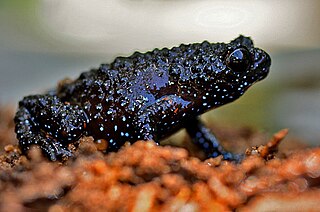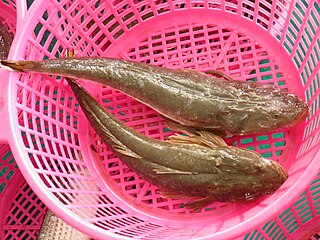
A zebu, sometimes known as indicine cattle or humped cattle, is a species or subspecies of domestic cattle originating in South Asia. Zebu are characterised by a fatty hump on their shoulders, a large dewlap, and sometimes drooping ears. They are well adapted to withstanding high temperatures, and are farmed throughout the tropical countries, both as pure zebu and as hybrids with taurine cattle, the other main type of domestic cattle. Zebu are used as draught and riding animals, dairy cattle, and beef cattle, as well as for byproducts such as hides and dung for fuel and manure. Zebu, namely miniature zebu, are kept as companion animals. In 1999, researchers at Texas A&M University successfully cloned a zebu.

The red-wattled lapwing is an Asian lapwing or large plover, a wader in the family Charadriidae. Like other lapwings they are ground birds that are incapable of perching. Their characteristic loud alarm calls are indicators of human or animal movements and the sounds have been variously rendered as did he do it or pity to do it leading to the colloquial name of did-he-do-it bird. Usually seen in pairs or small groups and usually not far from water they sometimes form large aggregations in the non-breeding season (winter). They nest in a ground scrape laying three to four camouflaged eggs. Adults near the nest fly around, diving at potential predators while calling noisily. The cryptically patterned chicks hatch and immediately follow their parents to feed, hiding by lying low on the ground or in the grass when threatened.

The Indian prawn, is one of the major commercial prawn species of the world. It is found in the Indo-West Pacific from eastern and south-eastern Africa, through India, Malaysia and Indonesia to southern China and northern Australia. Adult shrimp grow to a length of about 22 cm (9 in) and live on the seabed to depths of about 90 m (300 ft). The early developmental stages take place in the sea before the larvae move into estuaries. They return to the sea as sub-adults.

The Malayan tapir, also called the Asian tapir, Asiatic tapir, Oriental tapir, Indian tapir, or piebald tapir, is the largest of the five species of tapir and the only one native to Asia. The scientific name refers to the East Indies, the species' natural habitat. In the Malay language, the tapir is commonly referred to as cipan, tenuk or badak tampung.

Pterocarpus indicus is a species of Pterocarpus native to southeastern Asia, northern Australasia, and the western Pacific Ocean islands, in Cambodia, southernmost China, East Timor, Indonesia, Malaysia, Papua New Guinea, the Philippines, the Ryukyu Islands, the Solomon Islands, Thailand, and Vietnam.

The jungle nightjar is a species of nightjar found in Bangladesh, India, and Sri Lanka. It is found mainly on the edge of forests where it is seen or heard at dusk. The taxonomy of this and related nightjars is complex and a range of treatments have been followed that cover this and several other nightjars in the Asian region. It was formerly called the grey nightjar or Indian jungle nightjar and sometimes included the East Asian grey nightjar as a subspecies.

The smallbelly catshark is a catshark of the family Scyliorhinidae found in the western Indian Ocean near Somalia, the Gulf of Aden, and Oman, at depths between 1,300 and 1,840 m. Its length is up to 34 cm, although this measurement is of an immature specimen. The smallbelly catshark is not well known. It is found on continental slopes, and is probably caught by bottom trawlers. The reproduction of the smallbelly catshark is oviparous.

Melanobatrachus is a genus of narrow-mouthed frogs that contains a single species, Melanobatrachus indicus. It is known under a number of common names, including Indian black microhylid frog and Malabar black narrow-mouthed frog. It is endemic to wet evergreen forests of southern Western Ghats in Kerala and Tamil Nadu states of India. It has been recorded from Anaimalai, Munnar, Palni hills, Periyar Tiger Reserve and Kalakkad Mundanthurai Tiger Reserve

Morimus funereus is a species of beetle in family Cerambycidae. It is found in Greece, North Macedonia, Belgium, Croatia, Slovenia, the Czech Republic, Germany, Hungary, Italy, Moldova, Romania, Bulgaria, Serbia, Montenegro, Slovakia, Ukraine and Bosnia and Herzegovina. It is somewhat similar to another cerambycid, Rosalia alpina, which however is narrower and has three pairs of black spots. Also Herophila tristis has a similar body shape and markings, but the antennal segments 2 and beyond are much shorter.

Morimus is a genus of beetle in family Cerambycidae.

Melilotus indicus, sometimes incorrectly written Melilotus indica, is a yellow-flowered herb native to northern Africa, Europe and Asia, but naturalized throughout the rest of the world.
M. indicus is among the most important members of zygomycetes fungi. This dimorphic fungus is capable of production of several valuable products.

The bartail flathead, also called bar-tailed flathead, bartail blenny, gobi, Indian flathead, or Indo-Pacific flathead, is the type species for the fish genus Platycephalus. It is found in the Indian Ocean and western Pacific Ocean. The species has been recorded in the Mediterranean, having invaded as a Lessepsian migrant through the Suez Canal. However, although a number of specimens were caught in trawls in the late 1970s then none were caught until 2011, when one was taken off Lebanon. Following the revision of genus Platycephalus in Australia, Australian specimens previously assigned to this species are now considered a separate species, Platycephalus australis.
The Rennell Island monitor is a species of monitor lizards found in the Solomon Islands archipelago. It is also known as the Hakoi Monitor. It belongs to the subgenus Euprepiosaurus along with the canopy goanna, the peach-throated monitor, Kalabeck's monitor, and others.

Morimus asper is a species of beetle in family Cerambycidae.
Phrissomini is a tribe of longhorn beetles of the Lamiinae subfamily. It was described by Thomson in 1860.
Morimus granulipennis is a species of beetle in the family Cerambycidae. It was described by Stephan von Breuning in 1939. It is known from Myanmar.
Morimus lethalis is a species of beetle in the family Cerambycidae. It was described by James Thomson in 1857. It is known from India, Vietnam, China, and Thailand.
Morimus orientalis is a species of beetle in the family Cerambycidae. It was described by Reitter in 1894. It is known from Turkey, Bulgaria, and Iran.














